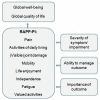Patient perspective of measuring treatment efficacy: the rheumatoid arthritis patient priorities for pharmacologic interventions outcomes
- PMID: 20461786
- PMCID: PMC2886964
- DOI: 10.1002/acr.20151
Patient perspective of measuring treatment efficacy: the rheumatoid arthritis patient priorities for pharmacologic interventions outcomes
Abstract
Objective: Collaboration with patients with rheumatoid arthritis (RA) highlights that outcomes important to them include fatigue, coping, and life enjoyment. However, these are not commonly measured in clinical trials. There is little evidence about which outcomes patients would prioritize, or what factors influence patients' prioritization. Our objective was to develop a complementary core set with patients to promote inclusion of their priority outcomes in pharmacologic interventions.
Methods: Nominal groups were conducted with RA patients to rank 63 outcomes generated from previous in-depth interviews. A multicenter postal survey provided the final selection of core outcomes for the Rheumatoid Arthritis Patient Priorities for Pharmacologic Interventions (RAPP-PI), in which RA patients rated the importance of the priority outcomes from the nominal groups and ranked the top 6.
Results: Twenty-six patients participated in 5 nominal group discussions and reduced the 63 initial outcomes to the 32 most important. A total of 254 participants in the survey ranked priority treatment outcomes to form the RAPP-PI: pain, activities of daily living, joint damage, mobility, life enjoyment, independence, fatigue, and valued activities. The 8 priorities represent 3 domains of treatment outcomes: direct impact of RA, psychosocial well-being, and function/participation. Chi-square tests showed that disease severity, disease duration, sex, and patients' perceptions of managing, self-efficacy, and normality influenced the selection of priority treatment outcomes.
Conclusion: Collaboration with patients has captured their perspectives of priority outcomes from pharmacologic interventions. Although there is some overlap with professional core outcomes, the additional use of this complementary set will give a broader evaluation of effectiveness of interventions from the key stakeholders: patients.
Figures
References
-
- McPherson KM, Brander P, Taylor WJ, McNaughton HK. Living with arthritis -- what is important? Disabil Rehabil. 2001;23(16):706–21. - PubMed
-
- Carr A, Hewlett S, Hughes R, Mitchell H, Ryan S, Carr M, et al. Rheumatology outcomes: The patient’s perspective. J Rheumatol. 2003;30(4):880–3. - PubMed
-
- Ahlmen M, Nordenskiold U, Archenholtz B, Thyberg I, Ronnqvist R, Linden L, et al. Rheumatology outcomes: The patient’s perspective. A multicentre focus group interview study of Swedish rheumatoid arthritis patients. Rheumatology. 2005;44(1):105–10. - PubMed
-
- Marshall NJ, Wilson G, Lapworth K, Kay LJ. Patients’ perceptions of treatment with anti-TNF therapy for rheumatoid arthritis: A qualitative study. Rheumatology. 2004;43:1034–8. - PubMed
-
- Edwards J. An exploration of patients experiences of anti-TNF therapy. Musculoskeletal Care. 2004;2(1):40–50. - PubMed
Publication types
MeSH terms
Substances
Grants and funding
LinkOut - more resources
Full Text Sources
Medical
Research Materials
Miscellaneous



